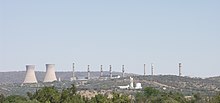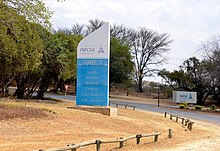Pelindaba
Pelindaba is South Africa's most important nuclear research center near the Hartbeespoort reservoir , about 33 kilometers west of Pretoria . It has been operated by the state-owned Nuclear Energy Corporation of South Africa (NECSA) since 1999 and was the place where South African atomic bombs were developed, built and then stored in the 1970s . According to the US State Department , South Africa is said to have carried out a nuclear test ( Vela incident ) off its coast in September 1979 with an explosive force of 2.5 to 3 kilotons .
Radiation research and nuclear waste disposal are currently the main areas of work. The research center operates a 20 MW reactor and a particle accelerator with a 4 megavolt Van de Graaff generator .
The research reactor was planned in 1960 as part of the peaceful atomic program Atoms for Peace , was named SAFARI-1 (for 1st South African Fundamental Atomic Research Installation ) and ran from 1965 with an initial output of 6.75 MW. The performance was limited by the cooling system. In 1968 the output was increased to 20 MW after the capacity of the cooling system had been expanded. Highly enriched uranium from the USA was initially used as the fission material.
In 1970, the state-controlled Uranium Enrichment Corporation (UCOR) was founded with the aim of building an enrichment plant, called Valindaba , Pelindaba East or Y-plant , in Pelindaba. In the same year, Prime Minister Balthazar Johannes Vorster informed parliament that the South African Atomic Energy Board had promoted a unique concept of uranium enrichment based on gas nozzle technology. Construction of the experimental uranium enrichment plant began in 1971. It was operational from March 1977 and supplied the fissile material from January 1978. In the middle of 2006 there was a switch to low-enriched uranium. In September 1989, President Frederik Willem de Klerk gave orders to end the nuclear weapons program. Uranium from the decommissioned South African nuclear weapons is currently being used.
According to some sources, South Africa acquired the technology of the uranium enrichment plant in Valindaba through cooperation with German companies and scientists. Fissile material was delivered from here to the operation of the Koeberg nuclear power plant . The German government confirmed at the time that there was a cooperation between the South African ESCOM and the private institute for reactor safety , which was discontinued in 1976 after their objection. In the course of this cooperation, aspects of the choice of location and construction issues were addressed, and South Africans were allowed to work in German nuclear research institutions.
Web links
- South African Nuclear Energy Corporation (NECSA) website
- Thomas B. Cochran: Highly Enriched Uranium Production for South African Nuclear Weapons . In: Science & Global Security, 1994, Volume 4, pp. 33-48. online at www.fas.org (English; PDF; 1.9 MB)
- David Albright: South Africa's Secret Nuclear Weapons. (ISIS Reports), 1994 . Ed .: ISIS , online at www.isis-online.org (English)
- Zondi Masiza: A Chronology of South Africa's Nuclear Program . online at www.auteurs.harmattan.fr (English)
Individual evidence
- ↑ Laurie Nathan, Jacklyn Cock: War and society: the militarization of South Africa . Claremont (David Philip) 1989, part 2, p. 6 Introduction, ISBN 0-86486-115-X
- ↑ NECSA: Research (English), accessed on February 2, 2016
- ↑ Michael Schaaf: Nuclear fission in the heart of darkness. Africa and the origins of the nuclear age in: Vera Keizer (Ed.): Radiochemie, Diligence and Intuition. New research on Otto Hahn. Berlin 2018. ISBN 978-3-86225-113-1
- ↑ Information at globalsecurity.org (English), accessed on December 23, 2015
- ↑ SAFARI-1: Achieving Conversion to LEU A Local Challenge - Report of the NECSA
- ↑ Thomas B. Cochran: Highly Enriched Uranium Production for South African Nuclear Weapons . In: Science & Global Security, 1994, Volume 4, SS 33–48 (PDF; 1.9 MB)
- ↑ Central Intelligence Agency: Weekly Surveyor, May 5, 1975 (PDF; 174 kB)
- ^ Ronald Meinardus: The Africa policy of the Republic of South Africa. Bonn 1981, p. 434.
- ^ Zdenek Červenka, Barbara Rogers: The nuclear axis. Secret collaboration between West Germany and South Africa. Friedmann, London 1978, ISBN 0-905290-01-1 .
- ^ SAIRR : Survey of Race Relations in South Africa 1979 . Johannesburg 1980, p. 86
Coordinates: 25 ° 48 ′ 2 ″ S , 27 ° 56 ′ 2 ″ E

